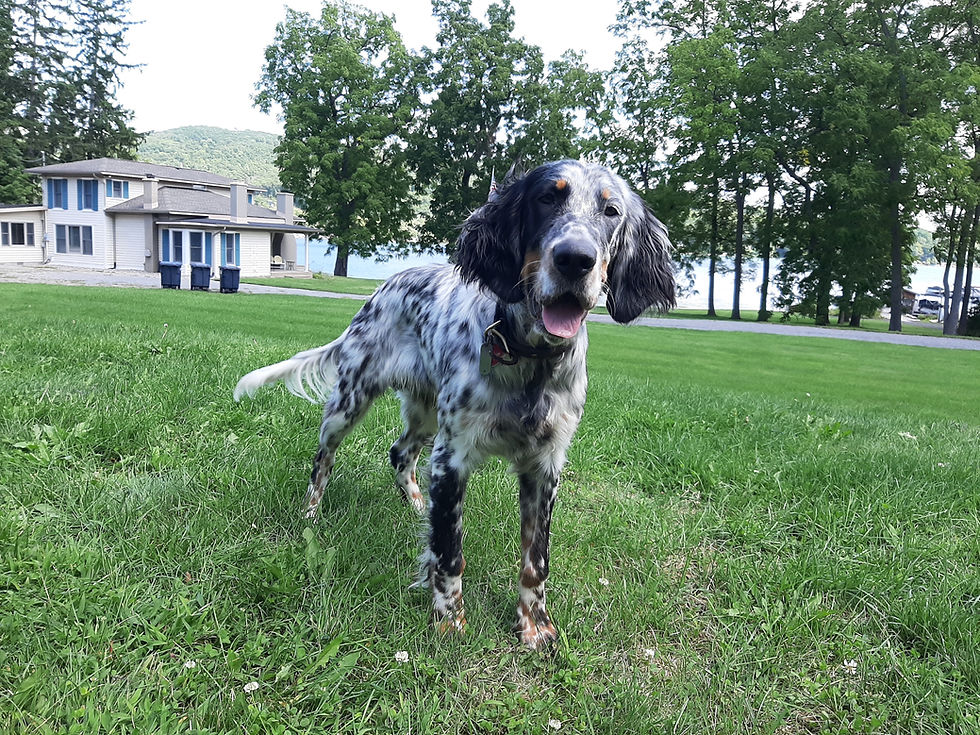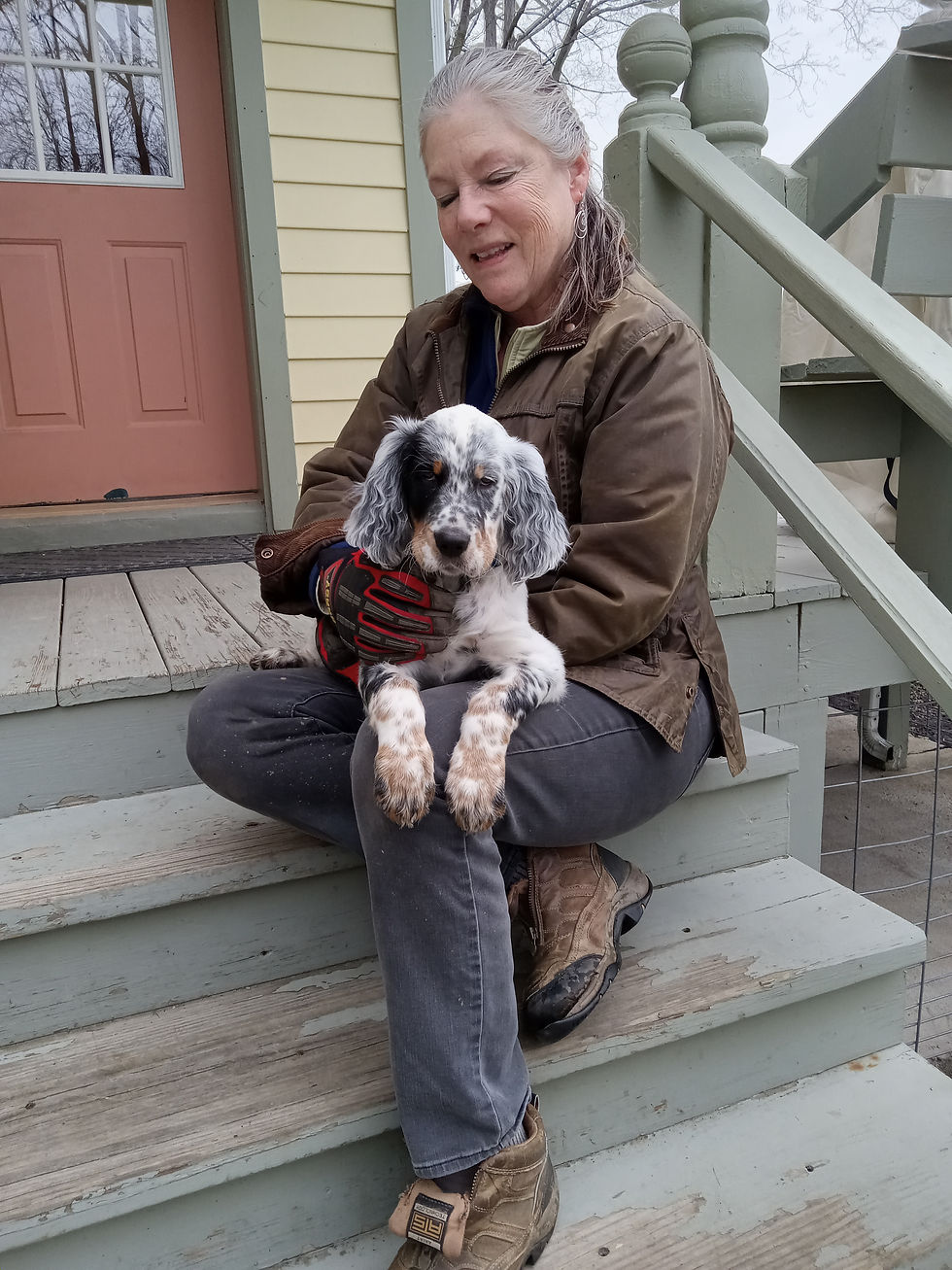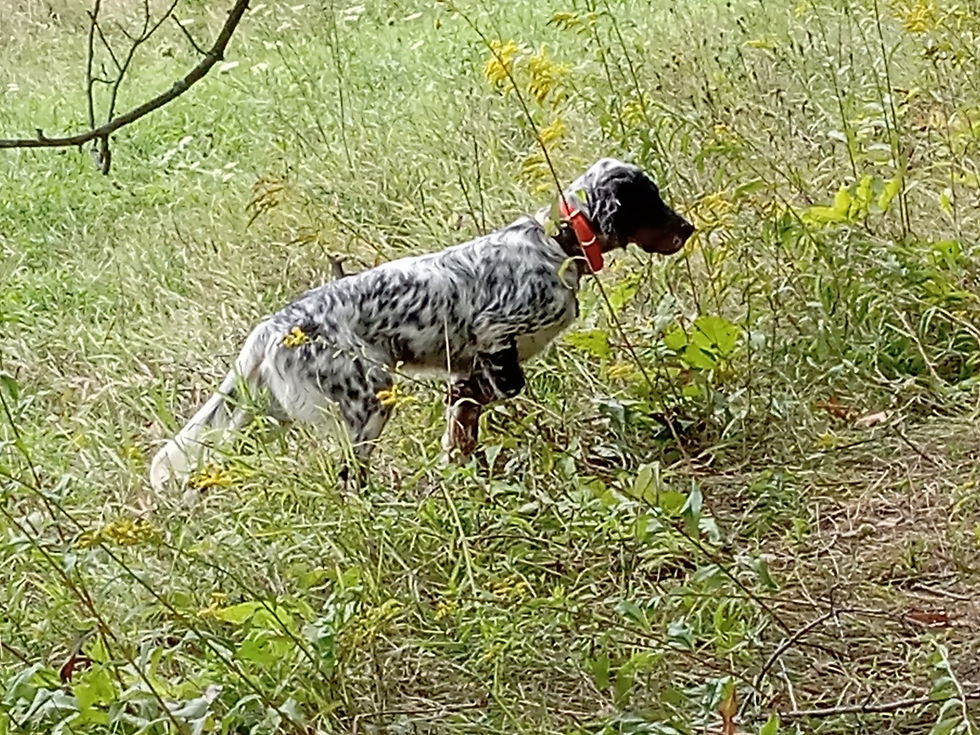
Okay, don't try to pronounce that, just call him Finn! More about that in a moment. Finn is a male pup we purchased from Classic Setters of Hartsburg, Missouri a little more than 4 months ago. He is now just past 6 months old now, and doing great. All the good puppy things have been happening since he came home with us last April. Physical development is going well, integration with our other dogs and daily routine, socialization, obedience training and fundamental's of field work have been fun and positive with this pup.

Why did we choose this pup, or maybe better, why did we choose to buy a pup from his litter? A great deal of thought went into that decision. Here are some major points.
We wanted to get back into having a male dog in our program. One dog is not the basis for every breeding going forward, but it will make another good male Ryman type dog potentially available in the East, and for us, cut out some of the major marathon trips we historically undertake to breed to good sires. His pedigree compliments our current females, and also what we think we will recruit for females in the near future.
His dam, Classic Fiona's Blue Bebee, is a dog very well known to us after several years sharing ruffed grouse and prairie camps with the entire Classic Setters line. We knew several dogs in her pedigree as well. She is true to the Ryman type we breed for, comes from several generations of healthy individuals, and demonstrates positive benefits from a couple strategic outcrosses several generations back to improve drive and intensity.
His sire, Hafrafells Mori, was brought into the USA from Iceland last year by Classic Setters. He comes from a European tradition of hunting English Setters that emphasizes characteristics also important to Ryman type breeders here in the US; drive and intensity on birds, biddable temperaments, genetically healthy, and pleasing but athletically sound conformation. The most recent generations in his pedigree demonstrate OFA screening for hips and elbows, and earlier ones have screening using a generally similar European evaluation process. Mori's first season in the USA was excellent. We were there for his first ruffed grouse and prairie hunts. He hit the covers hunting effectively like he had been here his whole life. Pups from the first US litter he sired were hunting last winter on pressured wild birds like experienced two year olds. Even though he represents an outcross, we are as confident of him as any other sire we ourselves have used in our breeding program. For some comments on that first litter, and concise thoughts on outcrossing, visit this post by our friends at October Setters.
This gave us the opportunity to participate in the evaluation of Mori as a contributor to the advancement of the Ryman type English Setter. As part of the group of breeders identified at RymanSetters.com, we were part of discussion by some members about what we might achieve bringing one or more dogs from Europe. Classic Setters followed though and were able to obtain Mori after a long process to identify a suitable candidate. One of the great advantages of being a very large kennel is the ability to keep an entire litter of pups for an extended period of time. George Ryman, Bob Wehle and others did this routinely. To emulate this, Mori's first US bred litter was distributed entirely within our breeder network. There, we will be able to watch each of those pups as it develops and matures, almost as if one breeder kept the whole litter. We had to pass on a pup from that litter. The only males available were orange and white and we are already saturated that way. Getting a pup from his next litter afforded us first pick, and gave us a contributing role in evaluation of this bold move in breeding.

So here is where we are at with Finn... First, realize all our early enthusiasm and positive experiences don't mean he is a breeding candidate yet. His first full season is coming up, with lots of potential work on wild birds. That will be critical. Early starting, high prey drive, quick to point, we will look for all those qualities in honest, wild bird hunting contexts. Having seen the tail end of "the bad old days" when dysplastic setters were far too common, we will be vigilant on OFA reviews of elbow and hip conformation. We will also be watching to see what becomes of littermates and the half siblings from Mori's first USA breeding. Since we got him in April, yard training has been fun and easy. As this is written, he weighs 52 lbs. and it looks like he will level out at about 60 lbs. Our early unstructured puppy romps at the farm transitioned in August to introduction to pen raised quail and chukars. That also has gone well. Finn has retrieved each of the dozen or so birds shot over him as we finished his introduction to birds and gun fire. Now its time to put aside the contrived training scenarios, do some scouting around home, and get out for some fun, as the book title says, "Come October"!
Ooops, this post opened with a promise to get back to his name. "Hrafn" is the Icelandic word for raven. It celebrates his Icelandic heritage and our recent immersion into bird watching. The "H" is silent so it pronounces something like Raa - fin, which we just reduced to Finn day to day.
This is cross posted in the blog at www.rymansetters.com

Commenti